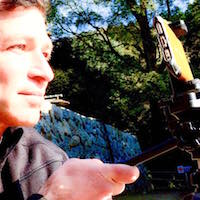Living in Japan you get used to the many little superficial acts of politeness expressed often and everywhere, like the bowing we are so used to seeing.
The Japanese even have a word to describe hospitality when it goes deeper, when it expresses one’s spirit; they call it omotenashi.
But I wasn’t prepared for Miyako.
I was far out in the countryside looking for a quaint, rustic train station for a film I was making. It was near the end of the day, so far had experienced no luck, and rather than continue driving, I asked my friend to let me jump on the next local train, and do just a little station hopping. My friend could pick me up at the next station.
The tiny one car train I caught pulled into Hokkeguchi, the final station I was checking out. There were only a few people on the train. Of course, I noticed the smiling woman who served as station master greeting the few people getting off the train, but I didn’t think much of it. I lingered for a few moments on the platform.
Then I noticed, truly out of the corner of my eye, the station master walking toward the very far edge of the platform. She just stood still as the train began passing her by. I watched her, curious. That’s when my own world suddenly stood still, as if holding its breath.
As the train pulled away into the distance, the station master began waving. Not like hello or goodbye, but with broad strokes as if she were painting the sky. Everything was so quiet. I watched her entranced, until a familiar inner voice yelled: film…film! (Because that’s what artists, especially film makers, do; we notice something, and feel an urge to capture it, bring it back.)
The sun was setting. The train passed only once an hour. The next train would be the last. I asked the station master if I could film her. She said yes. I then spent an hour just trying to figure out where to place the camera. I climbed a tree, imagining a bird’s eye view as best for capturing the whole scene. That was silly. In the end the camera is up close, right beside Miyako, where you can feel the fullness of the lovely, expansive surroundings.
I asked of her only two things: just be yourself, and: don’t…look…at…the…camera. She smiled.
On the surface it seems like she is expressing omotenashi; her wave is surely a deep expression of appreciation for the people using the train. Except that, no one on the train sees her. Especially when the train is nearly out of sight. And yet she still waves. It almost makes no sense to call it waving. And yet I have no other word appropriate to describe what she does. And she does it for each and every train, whether empty or full, even in the rain, even in the snow.
We talked afterwards. She told me that at first she felt shy waving at the departing trains, and just waved naturally, like we all might, but over time, the waves just became the way she expresses them now.
Waves that, for those who chance to experience them, simply slow down and quiet the world.
I have noticed that for the Japanese it’s often about the little things in life.
For me, Miyako expresses just how big a little thing can be.
Here’s the video, Miyako:
Author: Erez Sitzer
Editor: Sara Kärpänen
Photo: Author’s Own









Read 0 comments and reply